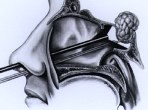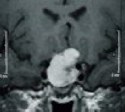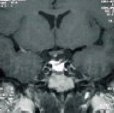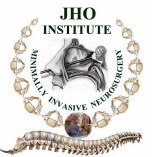Jho Institute for Minimally Invasive Neurosurgery Department of Neuroendoscopy
Spine Diseases
Brain Diseases
Craniopharyngioma, Craniopharyngioma Surgery: Dr. Jho's Endoscopic Brain Tumor Surgery
Dr. Jho's Minimally Invasive Craniopharyngioma Surgery, , Minimally Invasive Brain Surgery
Professor & Chair, Department of Neuroendoscopy
Jho Institute for Minimally Invasive Neurosurgery
Dr. Jho's minimally invasive surgical treatments for craniopharyngiomas
Although various minimally invasive techniques can be used, Dr. Jho mainly utilizes two types of minimally invasive surgical techniques in most craniopharyngiomas (depending on the location of the tumor). The first is an orbitofrontal craniotomy via a small eyebrow incision, and the second is an endoscopic endonasal approach via a nostril without a skin incision.
1. Dr. Jho's orbitofrontal craniotomy via a small eyebrow incision
A: B:
B: C:
C:
 B:
B: C:
C:
D: E:
E: F:
F: 
 E:
E: F:
F: 
Figure 1. Preoperative MR scans, axial (A) and sagittal views (B), display a large craniopharyngioma in the third ventricle. A patient following an orbitofrontal craniotomy via an eyebrow incision wears a small bandage at the right eyebrow area (C). Postoperative MR scans, axial (D) and sagittal (E) views, confirm complete tumor removal. Intraoperative endoscopic view reveals optic nerve system and anterior cerebral arteries in another patient after endoscoic craniopharyngioma removal (F).
2. Dr. Jho's endoscopic endonasal removal of craniopharyngiomas through a nostril without a skin incision.
A: B:
B: C:
C:
 B:
B: C:
C:
Figure 1. A schematic drawing (A) demonstrates how craniopharyngiomas are removed through a nostril. An endoscope is inserted in front of the tumor through a nostril and surgical instruments are inserted next to the endoscope through the same nostril for tumor removal. A preoperative MR scan, coronal view (B), reveals a recurrent craniopharyngioma that had recurred after previous tumor removal through a conventional frontotemporal craniotomy by another neurosurgeon (the tumor is white in color). The tumor was completely excised via a nostril using Dr. Jho's endoscopic technique. A postoperative MR scan, a coronal view (C), reveals complete tumor removal. The tumor site is reconstructed with an abdominal fat graft (white).
Information about craniopharyngiomas:
Craniopharyngiomas are benign brain tumors, which arise at the juncture between the brain, hypothalamus, and the pituitary gland (the center of the hormonal control of the entire body). It can be solid, cystic, or both. In the vicinity of this area is part of the optic system, consisting of the optic nerves (visual nerves coming from the eye), the optic chiasm (crossing part of the visual nerves above the pituitary gland), and the optic tracts (visual nerve cables heading to the brain). Also in the vicinity are the hypothalamus (which is a core portion of the brain that controls the vital functions of the body), the third ventricle (which conveys cerebrospinal fluid), and the pituitary gland.
Craniopharyngiomas produce symptoms by compression of the surrounding anatomy. Tumor compression at the pituitary gland or stalk produces endocrine disorders. Compression at the visual nerve system causes visual disorders, and compression at the hypothalamus can cause obesity, loss of body mass, or complex disorder of vital functions. The blockage of fluid passage at the third ventricle by tumor compression can produce hydrocephalus, which is accumulation of the cerebrospinal fluid (CSF) in the ventricles. Treatments includes observation, radiosurgery or radiation therapy, stereotactic aspiration of the cystic content, and/or surgical removal. The choice of treatments depends on the symptoms, the location, and the nature of the tumor.
Practice Manager: Robin A. Coret
Tel : (412) 359-6110
Fax : (412) 359-8339
Address : JHO Institute for Minimally Invasive Neurosurgery
Department of Neuroendoscopy
Sixth Floor, South Tower
Allegheny General Hospital
320 East North Avenue
Pittsburgh, PA 15212-4772
Copyright 2002-2032


